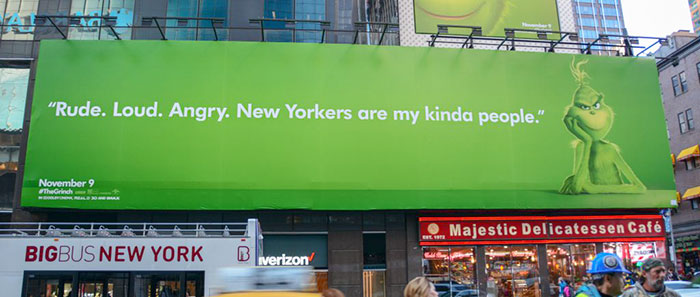
While the first billboard was built in the early 1800s, OOH advertising is believed to have existed for 40,000 years. Advertisers are becoming more creative with their branding efforts as this medium sees improved methodology improvements every year. In the past, it has been challenging to pinpoint precisely how, when, where, and whether an OOH advertisement reached its target demographic. Advertisers could evaluate the effectiveness of their campaigns by computing the number of possible viewers or the duration of a TV ad or out-of-home billboard. Thankfully, rapid technological innovation over the preceding five years has made it possible for advertisers to more precisely gauge the success of their campaigns. The effectiveness of OOH advertisements is currently assessed using techniques including GPS tracking devices, surveys, beacon technology driven by Wi-Fi connections, QR codes, social media involvement, and sales effect.
But, why?
Let’s move on to the data and facts. Just as with any marketing investment, you want to be able to analyze the ROI of your campaign and ultimately assess the effectiveness of your advertising. OOH advertising is now more accurately quantifiable than most other forms of advertising due to technological developments and its lengthy history of use. The outcomes you intend to achieve are the first important piece of information you must establish, just like with any advertising endeavor. We all want increased app downloads, click-through rates, or site traffic in addition to conversions, right? With the development of technology, we are now able to use trackable analytics to ensure that OOH advertising campaigns are both profitable and able to be enhanced for consecutive campaigns.

The Technology – what’s everyone doing?
The WiFi and Bluetooth signals from consumers are used by Movia to track who, what, where, and when their truck-side campaign advertisements are being viewed. With real-time impression analytics, mobile device retargeting, and ROI monitoring capabilities, the advertiser is able to optimise their campaign in order to make it as valuable and lucrative as possible.
In general, Geopath provides audience location measures by aggregating anonymous OOH audience statistics and focusing on the activities of a target audience rather than census data. Customers’ interactions with OOH adverts as they go about their daily lives are monitored. To gather a stream of concise information on the intended audience, they compile all of the data sources that are available. Clients are ultimately given more choices, clarity, and understanding regarding their marketing initiatives as a result of this.
Marketers can learn about the volume, regularity, and demographics of OOH ad campaign viewers from Route, one of the most recognised audience research companies in the UK. They give tracking movement details for everything and anywhere using a technique called Multi-Sensor-Tracking (MST). MST provides accurate information on trends and travel behaviours across the UK.
Similar to this, the Canadian Out Of Home Measurement Bureau (COMMB) offers planners a helpful interactive mapping tool that enables them to display and assess the effectiveness of both currently available static and digital OOH products and networks.
The performance-driven ad technology platform Wrapify is adopting a novel strategy for how it shares its data with businesses and brands with whom it partners. They can assess the effectiveness of OOH advertisements as people walk through or drive through the campaign zone using their special OOH impressions tracking technology. Then, after logging in to their campaign dashboard, advertisers can view the stats immediately. With only a few clicks of a button, advertisers can quickly and simply track the attribution, retargeting, impressions, miles, heat maps, and daily routes of their ads.
Impressions
The benchmark for measuring the effectiveness of your OOH marketing is impressions. The audience that your advertisement is reaching is what impressions ultimately refer to, and they are frequently expressed as weekly figures. Impressions are a gauge of how frequently a particular consumer views your advertisement on average. These data may contain everything from travel surveys to data modelling to traffic statistics.
OOH can quantify impressions, which is essentially a very precise estimation of the number of people who will see the content of your advertisement when they are passing by it. Utilizing methods like census data, data modelling, and trip surveys, impressions can be evaluated. Previously, this kind of data was dependent on memory, but today’s versions are more accurate and capable of providing information immediately. For this, Wi-Fi and GPS signals are employed. For instance, 48 or 96-sheet billboards are regularly erected along well-traveled commuting routes and at wayside sites. This kind of information is crucial for OOH advertisers since it helps them comprehend the behaviours and trends of their target market.

International Industry Standards
Television has not produced globally accepted audience measurement standards; only out-of-home advertising has. The worldwide research organisation ESOMAR has sponsored these standards, which have the backing of the World Federation of Advertisers (WFA), the European Association of Communications Agencies (EACA), and the 4As. National and international best practises and research standards now have a solid foundation thanks to the OOH recommendations.
Marketers must measure their campaigns systematically before, during, and after their deployment in order to guarantee that reliable data and information are obtained throughout the process. Now, marketers can paint a nuanced picture of OOH audience mobility.
Marketers can make advantage of these industry standards before, during, and after their OOH venture.
Internet Trails
Your OOH ad may be measured quickly and easily with digital trails. Imagine that your mobile advertisement has a promo code or that you link your social network accounts; in this case, traceable data can be linked to social media followings and promo code usage
How can the effectiveness of an outdoor advertising campaign be evaluated using technology?
The success of your OOH campaign and its influence on consumer behaviour should be taken into consideration whether your goal is to increase brand recognition and awareness or merely to maximise sales of a specific product or range.
Track sales
Ideally before, during, and after the campaign, monitoring sales is undoubtedly the simplest and most fundamental technique to determine the effectiveness of OOH media. You can also combine this data with regular sales figures over an extended period of time to determine any sales spikes and the most plausible causes behind them.
It’s not advisable to rely solely on this approach to gauge the success of your marketing campaigns. Even though it seems straightforward, this method of assessing efficacy isn’t the most precise. If several campaigns are run simultaneously, it is very impossible to establish which of them is truly bringing in money for your firm. It would be wise for your company to use a number of tools, such sales tracking, to evaluate effectiveness and return on investment.
Tracking Digital trails
If you’re ready to engage with more complicated techniques for determining effectiveness, you might consider creating promo codes and coupons that are targeted expressly for commercials. The same concept can be applied to the usage of QR codes and campaign-specific URLs, provided that they are only viewable through your OOH media and only under particular conditions. Additionally, recent studies have shown that OOH media, especially online and through social media platforms like Instagram, is widely seen as a prodigious generator of online activations and brand searches.
Along with coming up with a specific phrase for your OOH ad campaign, you might consider driving web visitors to a microsite that is customised to your advertisement and messaging. When a new product is being released and you solely want to use your OOH campaign to market it, this is very beneficial. The microsite’s URL should be prominently displayed on the billboard or ad, according to best practises. To find out how many individuals visited the microsite directly online, utilise Google Analytics from here. This can provide you with a startlingly accurate idea of the strength and scope of your message.
Social Media
OOH advertising has the potential to provide distinctly immersive and appealing brand experiences, which is why images of creative outdoor advertisements are widely shared on social media. However, because the tracking technology used to track consumer actions like website visits cannot be used on third-party websites, OOH advertising meant to drive social mentions require their own unique brand of measurement tactics. A common way of evaluating social mentions is the examination of the rise in usage of pre-determined hashtags, although this method only records posts with the correct hashtag, which is often a small percentage of all relevant posts.
OOH and social media marketing are strongly intertwined, with the former increasingly likely to lead to activations on sites like Twitter and Instagram. As a result, develop a memorable hashtag to engage potential customers offline. This is one of the best techniques to evaluate the effectiveness of OOH or billboards. Even though you have a variety of tools at your disposal to assist you choose the hashtags that will connect with your audience, hashtags have unquestionably grown in popularity in the world of social media marketing. By prominently promoting your hashtag in your advertisement, you can accurately and insightfully track any social media engagement that happens following the publication of your advertisement. You may find out more about the people who are searching for your company online through social media sites, which could lead to future research that is much more insightful.
There are a variety of additional techniques, including brand surveys, SMS direct response, and vanity URLs. Multiple methods for a single campaign are frequently used in the optimal measuring plan.
Conclusion
As we can see, assessing your OOH advertising has never been easier thanks to innovation and the availability of a variety of technology. There are various ways to measure both the impressions that an OOH ad creates and its subsequent influence on sales, so the secret is to select the metrics that are most appropriate to your budget, content, and major marketing goals.
If you want to harness the power of OOH advertising for your company and require the resources to do it successfully, get in touch with our OOH experts right away!


